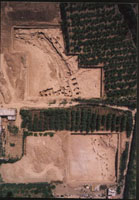New Discoveries at the Taiyechi Imperial Garden of the Tang Dynasty
In the Spring of 2005, in its last-season fieldwork at the Taiyechi Imperial Garden of the Tang Dynasty, the China-Japanese Joint Expedition[1] excavated the southeastern shore of the western pond of this garden complex, which corresponds to the area to the south of the Sunjiawan Village, Daminggong Xiang, Weiyang District, Xi’an. This excavation, over 2800 m2 in dimension and 3m in depth, harvests the following important discoveries.



1. The plan of the southeastern shore of the Taiyechi Pond
The shore of this section, constructed out of earth-ramming, runs from northeast windingly to southeast, with gentle or steep (propped by wooden planks and logs) wall. The shore is about 1.5m above the bottom of the pond.
2. The corridor and pavilion on the water
Inside the shoreline there is a line of thick debris of bricks and tiles (long-bar bricks, square bricks, cylindrical tiles, and bird-form tile-ends). Underneath the debris are densely set postholes (up to 1,000 in total) arranged in neat rows. There is good reason to surmise that corridor(s) and pavilion(s) were originally built upon the water surface here.
In addition, at the points where the shoreline protrudes into the pond are found several rows of pits of posts on the bottom. The pits, rectangular and circular in plan, bear trace of posts on the bottom and wall. Those pits within the pond, laden with firing residue, form a rectangular space coupled with sizable debris of dilapidated stone structural parts nearby.
The structural remains stated above indicate that in the pond were constructed above-water structures of the pavilion kind, which reached the shore via a corridor-like bridge.
3. Great patches of lotus leaves in the silt of the pond. Many of them preserve stems and seeds. On a stone is even left tangible imprint of watery grass. In the silt is kept a good deal of conch shells of various sizes. These remains vividly portray to us an appealing view of endless lotus leaves and buds over the pond.


4. A plenty of fine objects of the Tang palaces. The greatest number is of bricks and tiles, which include lotus-designed tiles, square bricks, long-bar bricks, and bird-form tile-ends. Of high-grade porcelains are mi-se (mystical color) petal-formed bowls of the Yue Kiln, white bowls with the盈 (ying) and官 (guan) characters of the Xing and Ding Kilns respectively, tri-color wares and striped pillows of the Gongxian Kiln. Other finds are copper ornaments on wooden wares, copper and iron plaques, and iron nails, “开元通宝 (Kaiyuan tongbao)” coins, and stone post stands and balustrades. Of particular interest is a well-preserved stone board, which, bearing in its center a carved dragon with carefully rendered scales and clouds underneath the dragon feet, appears to be a masterpiece of Tang stone works. The pillar with sculpted lotus seat and sitting lions upon the board is also an unprecedented work of Tang arts. All these fresh data provide a solid ground for reconstructing palace complexes of the Tang Dynasty. In addition, there are round sculptures of Rhinoceros and lions.
In sum, the new discoveries of this year greatly upgrade our knowledge of the imperial garden complex of the Taiyechi Pond of the Tang Dynasty.
[1] The China-Japanese joint excavation project at the Taiyechi Imperial Garden of the Daminggong Palace was initiated in August of 2001. In the past four years, the excavation carried out six large-scale excavations on the shore around the Taiyechi pond and the island in the middle of the pond, altogether over 200,000 square meters. These excavations succeeded in exposing the plan of the pond shore, the corridors and buildings around the pond, and the rock piles, rock forest, pebble pavement, and curvilinear canals. They therefore brought to light the grand imperial garden of the Tang Dynasty, and enriched our knowledge of this complex provided by the given historical texts.

